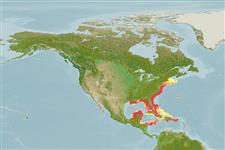Environment: milieu / climate zone / depth range / distribution range
Écologie
marin; saumâtre démersal; profondeur 0 - 183 m (Ref. 26268), usually 1 - 30 m (Ref. 26268). Subtropical; 45°N - 15°N, 94°W - 65°W (Ref. 26268)
Western Atlantic: New York south through the Florida Keys (USA), through the northern Gulf of Mexico to the Campeche Peninsula, Mexico, the Bahamas, and Cuba.
Length at first maturity / Taille / Poids / Âge
Maturity: Lm 10.1, range 8 - ? cm
Max length : 21.0 cm TL mâle / non sexé; (Ref. 52683)
Rayons mous dorsaux (Total) : 85 - 92; Rayons mous anaux: 69 - 72. Eyed side dark brown, sometimes with narrow bars; large blackish patch on opercle.
Very abundant in shallow coastal waters and estuaries. Found on soft muddy bottoms. Feeds mainly on small benthic invertebrates, principally small crabs, polychaetes, copepods, amphipods and ostracods.
Life cycle and mating behavior
Maturities | Reproduction | Spawnings | Egg(s) | Fecundities | Larves
Robins, C.R. and G.C. Ray, 1986. A field guide to Atlantic coast fishes of North America. Houghton Mifflin Company, Boston, U.S.A. 354 p. (Ref. 7251)
Statut dans la liste rouge de l'IUCN (Ref. 130435)
Menace pour l'homme
Harmless
Utilisations par l'homme
Pêcheries: intérêt commercial mineur
Outils
Articles particuliers
Télécharger en XML
Sources Internet
Estimates based on models
Preferred temperature (Ref.
123201): 17.7 - 27.9, mean 24.4 °C (based on 406 cells).
Phylogenetic diversity index (Ref.
82804): PD
50 = 0.5000 [Uniqueness, from 0.5 = low to 2.0 = high].
Bayesian length-weight: a=0.00437 (0.00352 - 0.00541), b=3.19 (3.13 - 3.25), in cm total length, based on LWR estimates for this species (Ref.
93245).
Niveau trophique (Ref.
69278): 3.2 ±0.40 se; based on food items.
Résilience (Ref.
120179): Milieu, temps minimum de doublement de population : 1,4 à 4,4 années (tmax=5).
Fishing Vulnerability (Ref.
59153): Low to moderate vulnerability (32 of 100).
